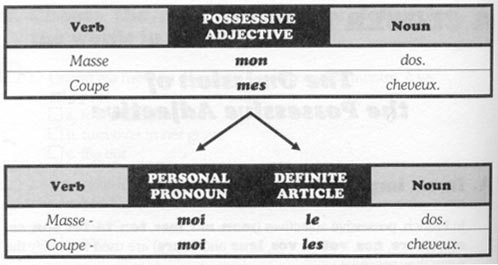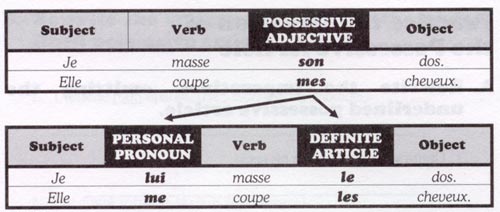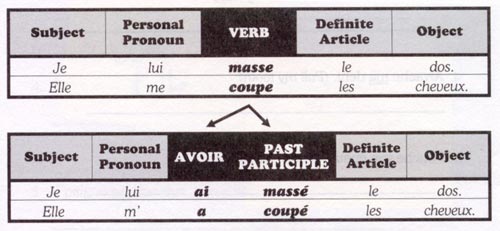A Closer Look I
| |
|
|
|
|
The Omission of the Possessive Adjective
A. In an imperative or command
In French, possessive adjectives (mon, ma, mes, ton, ta, tes, son, sa, ses, notre, nos, votre, vos, leur and leurs) are used to modify the noun they precede:
Voici ma mère.
This is my mother.
Regarde ma nouvelle voiture!
Look at my new car!
A common construction used by French natives is one where the possessive adjective is dropped in an imperative or command (and replaced with a definite article along with a personal pronoun) only if an action is being taken on a physical attribute (head, back, arm, etc.). For example, in the following, action is not being taken on the physical attribute; therefore, the possessive adjective remains:
Regarde mon dos.
Look at my back.
Remarque mes cheveux.
Notice my hair.
In the following, an action is being taken on the physical attribute:
Masse-moi le dos.
Massage my back.
Coupe-moi les cheveux.
Cut my hair.
Tiens-moi la main.
Hold my hand

B. In a statement
The possessive adjective may also be dropped in a statement only if an action is being taken on the physical attribute. In the following, an action is not being taken:
Je regarde son dos.
I'm looking at his/her back.
Elle remarque ses cheveux.
She's noticing his/her hair.
In the following, an action is being taken on the physical attribute:
Je lui masse le dos.
I'm massing his/her back.
Elle me coupe les cheveux.
She's cutting my hair.
The possessive adjective takes the form of the appropriate personal pronoun and is placed befored the verb, and a definite article is placed before the object. The same applies to pronominal verbs (when the action is being done to oneself):
I wash my hands = Je me lave les mains.
She brushes her hair = Elle se brosse les cheveux

C. In the past tense (passé composé)
In the past tense as well, the personal pronoun is placed after the subject (just as it was the prensent tense).

D. In the past tense using pronominal verbs
The construction here is much like that of “C” above with the exception that, as with all reflexive verbs, the past participle is conjugated with "être" :

